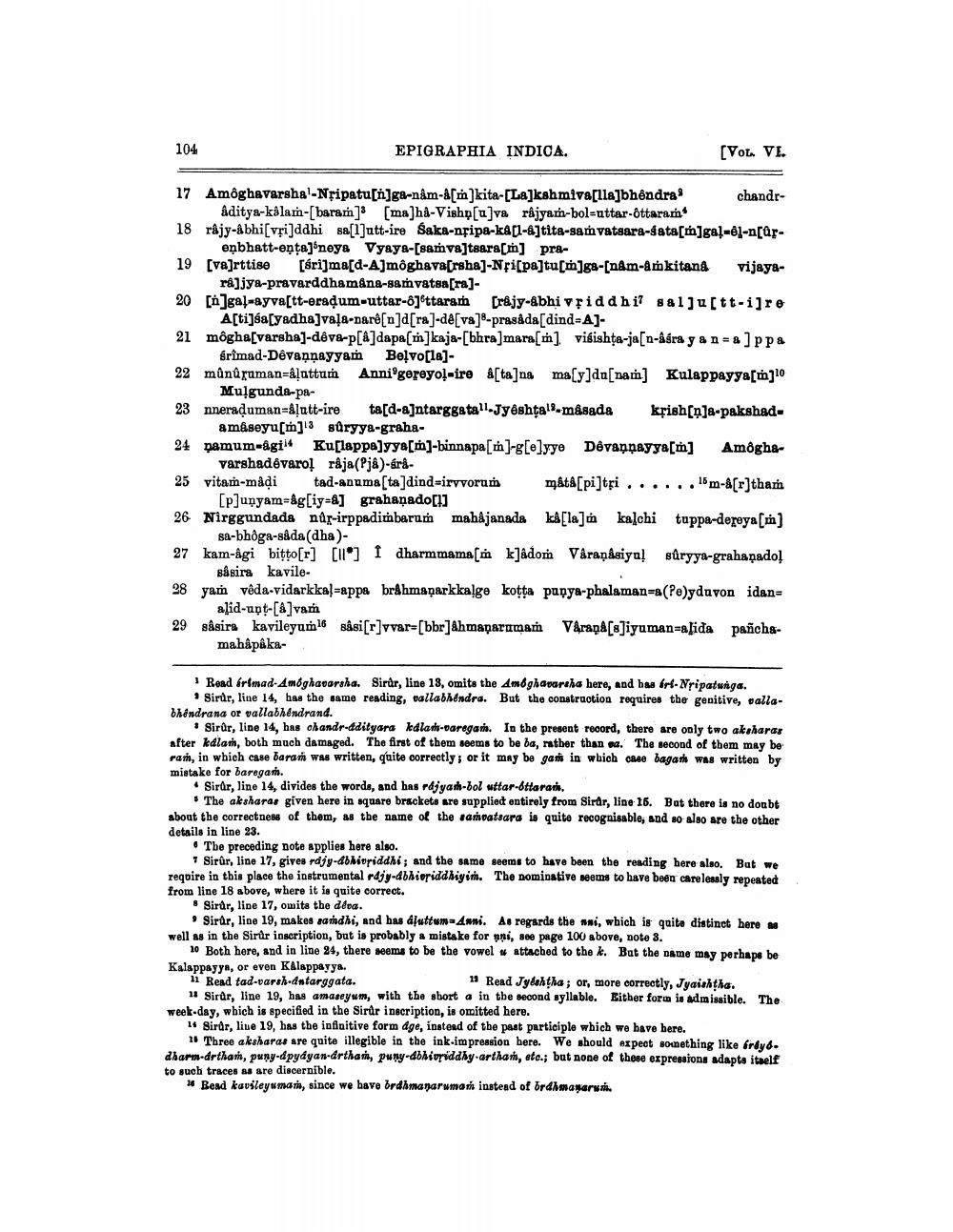________________
104
EPIGRAPHIA INDICA.
[Vol. VI.
17 Amôghavarshal-Nřipatu[n]ga-nam-a[mm]kita-[La]kshmivalla]bhêndra chandr
Aditya-kəlam-[baram] [ma]hå-Vishọ[u]va rajyam-bol=uttar-êttaram 18 râjy-abhi(vrijddhi sa[ljutt-ire Saka-nfipa-ka[1-4]tita-samvatsara-data[rn]gal-êl-ncar
eņbhatt-enţa]éneye Vyaye-[samvajtsara[m] pra19 [va]rttise [srijma[d-Ajmôghava[rsha]-Nfi[pa]tu[m]g8-[nam-amkitand vijaya
rájjya-pravarddhamana-samvatsa[ra]20 [n]gal-ayva[tt-eradum-uttar-6]øttaram [rêjy-abhi vriddhi? 881]u[tt-i]re
A[ti]ša[yadha]vaļa-Dare[n]d[ra]-de[va] 8-prasada dind=4]21 môgha[varsha]-dêva-p[A]dapa[m]kaja-[bhra]mara[m] vifishta-ja[n-asra y a n = a ]ppa
Srimad-Dêvannayyam Belvo[18] - 22 mûnuruman=aļattum Anni gereyol-ire A[ta]na ma[y]do[nam] Kulappayya[m]
Mulgunda-pa23 neraduman=&ļutt-ire ta[d-a]ntarggatall-Jyêshtal-misada krish[n]a-pakshad
amåseyu[m] suryya-graha24 namum-agi Kuslappa]yya[m]-binnapa[mn]-[e]yye Dôvannayya[m] Amogha
varshadêvaro! râja(Pja)-árå25 vitam-madi tad-anuma[ta]dind=irvvorum mata[pi]tsi ...... 18m-8[r]than
[p]unyam=&g[iy=&] grahaņado [1] 26 Nirggundada nûr-irppadimbaruń mahajanada ka[la] in kalchi tuppa-deroya[m]
sa-bhôga-såda (dha)27 kam-agi bitto[r] [ll] I dharmmama[i k]ådom Våraņâsiya! sûryya-grahaņado!
såsira kavile28 yaṁ vêda-vidarkkal-appa bråhmaņarkkalge kotta punya-phalaman=a(Pe)ydavon idan=
alid-apt-[&]vam 29 sâsirs kavileyun 16 såsi[r]vvar=[bbr] Ahmaparumam Våraņa[s]iyuman=alida pañchs
mahapaka
Read Grimad-Amoghavarsha. Sirûr, line 18, omits the Amoghavareha here, and has brf-Nripatunga.
• Sirúr, line 14, has the same reading, vallabhandra. But the constration requires the genitive, vallabhendrana or vallabhendrand.
Sirûr, line 14, has oh andr-ddityara kedlar-varegan. In the present record, there are only two akaharas after kdlath, both much damaged. The first of them seems to be ba, rather than ea. The second of them may be ran, in which case barani was written, quite correctly; or it may be gat in which cane bagarh was written by mistake for baregai.
* Sirar, line 14, divides the words, and has rdjyash-bol uttar-áttaran.
. The akshara, given here in square brackets are supplied entirely from Sirar, line 16. But there is no doubt about the correctness of them, as tbe name of the samvatsara is quito recognisable, and so also are the other details in line 23.
• The preceding note applies here also.
+ Sirûr, line 17, gives rdjy-dbhidriddhi; and the same seems to have been the reading here also. But we regoire in this place the instrumental rdjy-dbhiosiddhiyit. The nominative seems to have been carelessly repeated from line 18 above, where it is quite correct.
* Sirur, line 17, omits the deva.
Sirar, line 19, makes sandhi, and bas dfuttun-anni. As regards the wni, which is quite distinct here as well as in the Sirur inscription, but is probably a mistake for ni, see page 100 above, note 8.
10 Both here, and in line 24, there seems to be the vowel + attached to the k. Bat the same may perhaps be Kalappayya, or even Kalappayya. 11 Read tad-varsh-dntarggata.
13 Read Jydahtha; or, more correctly, Jyaishtha. 11 Sirar, line 19, has amaseyum, with the short a in the second syllable. Either form is admissible. The week day, which is specified in the Sirûr inscription, is omitted here.
14 Sirdr, live 19, has the influitive form dge, instead of the past participle which we have here.
11 Three aksharas are quite illegible in the ink.impression here. We should expect something like indys. dharm-drthan, puny-dpydyan.drthan, puny-dbhivriddhy.arthan, etc.; but none of these expressions adapta itself to such traces as are discernible.
# Bead kavileyuman, since we have brdhmanaruman instead of ordhmayari




